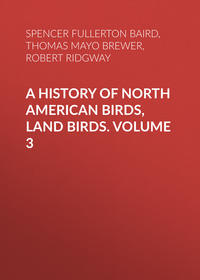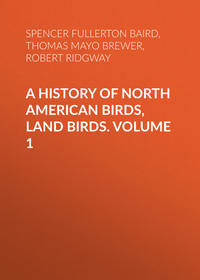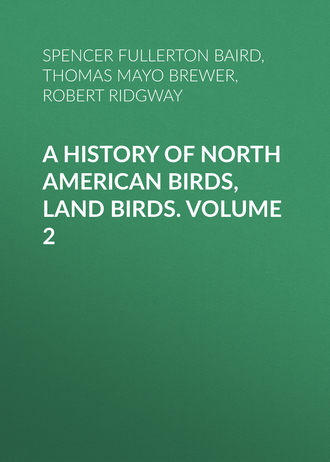 полная версия
полная версияA History of North American Birds, Land Birds. Volume 2
The eggs measure .50 by .35 of an inch, and are of a pure dull white.
Trochilus alexandri, Bourc. & MulsantBLACK-CHINNED HUMMING-BIRDTrochilus alexandri, Bourcier & Mulsant, Ann. de la Soc. d’Agric. de Lyons, IX, 1846, 330.—Heermann, J. A. N. Sc. Phila. 2d ser. II, 1853, 269.—Cassin, Ill. N. Am. Birds, I, V, 1854, 141, pl. xxii.—Gould, Mon. Trochilidæ, XIV, Sept. 1857, plate.—Baird, Birds N. Am. 1858, 133, pl. xliv, f. 3.—Ib. M. B. II, Birds, 6, pl. v, f. 3.—Heerm. X, S, 56.—Cooper, Orn. Cal. 1, 1870, 353.
Sp. Char. Very similar to Trochilus colubris. Tail slightly forked; the chin and upper part of the throat opaque velvety-black, without metallic reflections, which are confined to the posterior border of the gorget, and are violet, sometimes changing to steel blue or green, instead of coppery-red. Female without the metallic scales; the tail-feathers tipped with white; the tail graduated, not emarginated; the innermost feather among the longest. Length of male, 3.30; wing, 1.70; tail, 126; bill, .75.
Hab. Coast of California, southward, and east to the Wahsatch and Uintah Mountains, Utah.

♂ juv. Trochilus alexandri. 4963 ♀
The chief characters of this species are to be found in the violet, steel-blue, or steel-green reflections of the hinder part of the gorget, varying with the situation of the feathers and the specimen, as distinguished from the bright fiery or coppery red of the other. The chin and upper part of the throat extending beneath the eyes are opaque velvety or greenish black, without metallic lustre, while in T. colubris it is only the extreme chin which is thus dull in appearance. The bill is about .10 of an inch longer, the tail less deeply forked, and tinged with green at the end.
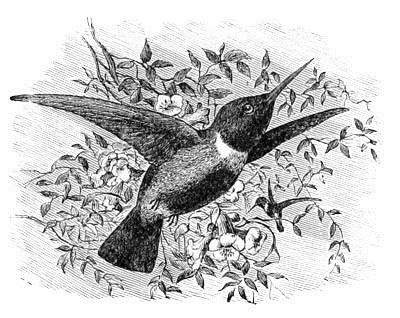
Trochilus alexandri.
It is exceedingly difficult to distinguish the female of this species from that of T. colubris. The size is rather larger, and the tail rounded, without any distinct emargination; the middle feathers being .15 of an inch longer than the lateral ones, instead of actually shorter. The color is much the same. The primaries are also much broader in the present species.
In both species the outer tail-feathers, though broader than in the male, are quite acutely pointed on the terminal third, one side or the other of which is slightly concave, instead of being linear to near the end, and rounded without any concavity, as in Selasphorus and Calypte.
Habits. This Humming-Bird, originally described as a Mexican species, is found from the highlands of that republic northward, not only to the southern borders of the western United States, but as far north as the 58th parallel. It was first discovered on the table-lands of Mexico, east of the city, by Signor Floresi, a distinguished naturalist, who devoted himself to the study of the Trochilidæ of Mexico, but was first added to the fauna of North America by Dr. Heermann, who detected it, and obtained several specimens, within the burying-ground of Sacramento City, Cal. There several pairs remained during the period of incubation, and reared their young, finding both food and shelter among the flowering plants of that cemetery. He found several of their nests which were essentially similar to the T. colubris.
Dr. Cooper met with this species along the Mohave River. He saw the first on the 3d of June. He also found one of their nests built in a dark willow-thicket in the fork of a tree, eight feet from the ground. Those afterwards found near Santa Barbara were all built near the end of hanging branches of the sycamore, constructed of white down from willow catkins, agglutinated by the bird’s saliva, and thus fastened to the branch on which it rested. These were built in the latter part of April, and early in May contained two eggs, exactly resembling those of the T. colubris, and measuring .51 by .32 of an inch.
Afterwards Mr. W. W. Holden obtained a specimen in the Colorado Valley, March 20.
Mr. J. K. Lord, one of the English commissioners of the Northwestern Boundary Survey, met with this species near his camping-place on the western slope of the Rocky Mountains. This was near a lake, by the margin of which, with other trees, grew a number of the black birch. On these trees he found a sweet gummy sap exuding plentifully from splits in the bark, and on this sap hosts of insects, large and small, were regaling themselves. As the sap was very sticky, numbers of the smaller winged insects were trapped in it. Busily employed in picking off and devouring these captive insects were several very sombre-looking Humming-Birds, poising themselves over the flowers, and nipping off, as with delicate forceps, the imprisoned insects. Upon securing one of these birds, he ascertained that it belonged to this species. This was pretty satisfactory proof that they are insect-eaters. Not only on this occasion, but many times afterwards, Mr. Lord saw this bird pick the insects from the tree; and the stomachs of those he killed, on being opened, were filled with various kinds of winged insects. He found this bird lingering around lakes, pools, and swamps, where these birches grow. They generally build in the birch or alder, selecting the fork of a branch high up.
This species bears a very close resemblance in size, appearance, and markings, to the common eastern species, but is readily distinguishable by the difference in the color of the chin and the shape of the tail.
In the spring of 1851, on a trip to Sonora, Mexico, Dr. Heermann found these birds abundant in the arid country around Guaymas, where amid the scanty vegetation they had constructed their nests in the month of April. He also afterwards found them on Dry Creek and the Cosumnes River.
According to the observations of Mr. Ridgway, this species has quite an extended distribution in the West. He found it in varying abundance from the Sacramento Valley, in California, to the Wahsatch and Uintah Mountains in Utah.
At Sacramento it was more abundant than the C. anna, nesting in the door-yards and in gardens, but particularly in the thick copses of small oaks in the outskirts of the city. In the Great Basin it associated with the Selasphorus rufus in the western portion, and with S. platycercus to the eastward, nesting everywhere, from the lowest valleys to a height of eight or nine thousand feet in the mountains.
Genus CALYPTE, GouldCalypte, Gould, Introd. Trochilidæ, 1861, 87. (Type, Ornysmya costæ.)
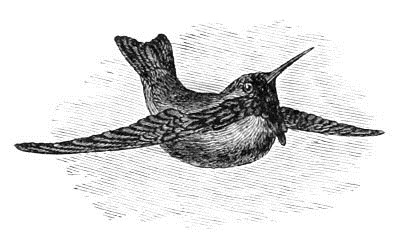
Calypte costæ.
39399 ♂ 39400 ♀
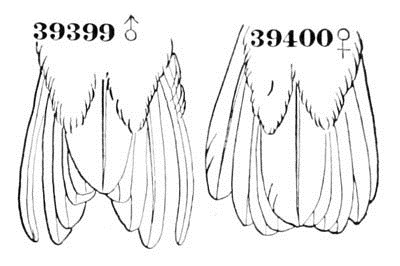
Calypte costæ.
Gen. Char. Bill longer than the head, straight or slightly curved; tail rather short. Outer primary not attenuated at end. Top of head, as well as throat, with metallic scale-like feathers, a decided and elongated ruff on each side the neck.
The metallic feathers on top of head, the attenuated outer tail-feathers (except in C. helenæ), and the elongated ruff, distinguish the males of this genus very readily from any other in North America.
SpeciesA. No rufous on tail-feathers; tail forked or emarginated.
a. Lateral tail-feather as broad as the others; tail emarginated. Rump and middle tail-feathers blue.
C. helenæ.114 Very small (wing, 1.15); metallic hood and ruff of the male purplish-red. Hab. Cuba.
b. Lateral tail-feather abruptly narrower than the others, tail forked. Rump and middle tail-feathers green.
C. anna. Large (wing, 2.00); outer tail-feather with a double curve, the end inclining outward. Metallic hood and ruff of the male purplish-red. Hab. California.
C. costæ. Small (wing, 1.75); outer tail-feather with a simple curve, the end inclining inward. Metallic hood and ruff of the male violet-blue. Hab. Southern California, Arizona, and Mexico.
B. Inner webs of tail-feathers mostly rufous, and outer webs edged with the same. Tail rounded. Lateral tail-feather abruptly narrower than the others.
C. floresi. 115 Size of C. anna. Hood and ruff of the male crimson. Hab. Table-lands of Mexico (Bolanos).
Calypte anna, GouldANNA HUMMING-BIRDOrnismya anna, Lesson, Oiseaux Mouches, 1830, (? pl. cxxiv. Trochilus anna, Jardine, Nat. Lib. Humming-Birds, I, 93, pl. vi.—Aud. Orn. Biog. V, 1839, 428, pl. ccccxxviii.—Ib. Birds America, IV, 1842, 188, pl. cclii.—Heerm. X, S, 56 (nest). Calliphlox anna, Gambel, Pr. A. N. Sc. Phil. III, 1846, 3.—Ib. Journ. 2d ser. I, 1847, 32. Trochilus (Atthis) anna, Reichenbach, Cab. Jour. Extraheft for 1853, 1854, App. 12. Trochilus icterocephalus, Nuttall, Man. I, (2d ed.,) 1840, 712 (male with forehead covered with yellow pollen). Atthis anna, Baird, Birds N. Am. 1858, 137. Calypte annæ, Gould, Introd. Trochilidæ.—Cooper, Orn. Cal. 1, 1870, 358.

Calypte anna.
5501 ♂ 44953 ♀
Sp. Char. Largest of North American species of Humming-Bird. Tail deeply forked; external feather narrow, linear. Top of the head, throat, and a moderate ruff, metallic crimson-red, with purple reflections. Rest of upper parts and a band across the breast green. Tail-feathers purplish-brown, darkest centrally. In the female the tail is slightly rounded, not emarginate; the scales of the head and throat are wanting. Tail barred with black, and tipped with white. Length, about 3.60; wing, 2.00; tail, 1.45.
Hab. Mexico and coast region of California.
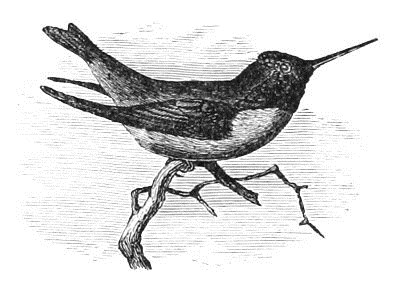
Calypte anna.
The C. floresi of the table-lands of Mexico resembles this species in every respect except the tail, which is somewhat like that of Selasphorus rufus. The only North American species to which the male of this bird bears any resemblance is the A. costæ, which has the same metallic crown and other generic features. The latter, however, is much smaller; has the metallic reflections varied, chiefly violet, instead of nearly uniform purplish-red. The tail is much less deeply forked, the depth being only about .10 of an inch, instead of .32; the outer feather is much narrower. The females of the two, however, appear to be distinguishable only by their relative size. The absence of rufous, and the rounded, not graduated, tail always separates the female of anna from that of Selasphorus rufus. The larger size is the chief distinction from the female Calypte costæ, while the size and less acutely pointed outer tail-feathers distinguish it from the female Trochilus colubris.
We have never seen any specimens of this bird taken out of California, nor quoted of late years as occurring in Mexico, although stated by Gould to belong to the table-lands.
Habits. This beautiful Humming-Bird is found from the high table-lands of Mexico throughout the western portions of that region, and through all the coast country of California, from the slopes of the Sierra to the ocean. It was first taken in Mexico, and named in honor of Anna, Duchess of Rivoli. Mr. Nuttall was the first of our own naturalists to take it within our territory. He captured a female on its nest near Santa Barbara. This was described and figured by Audubon. The nest was attached to a small burnt twig of Photinia, and was small for the bird, being only 1.25 inches in breadth. It was somewhat conic in shape, made of the down of willow catkins, intermixed with their scales, and a few feathers, the latter forming the lining. It had none of the neatness of the nests of our common species, and was so rough on the outside that Mr. Nuttall waited several days in expectation of its being completed, and found the female sitting on two eggs when he caught her. Dr. Cooper, however, thinks this description applies much better to the nest of T. alexandri, as all that he has seen of this species are twice as large, and covered externally with lichens, even when on branches not covered with these parasites.
Dr. Gambel, in his paper published in 1846 on the birds of California, describes this as a very abundant species, numbers of which pass the entire winter in California. At such times he found them inhabiting sheltered hillsides and plains, where, at all seasons, a few bushy plants were in flower and furnished them with a scanty subsistence. In the latter part of February and during March they appeared in greater numbers. About the Pueblo the vineyards and the gardens were their favorite resort, where they build a delicate downy nest in small flowering bushes, or in a concealed spot about a fence. In April and May they may be seen in almost every garden.
In the wilder portions of the country Dr. Gambel found them attaching their nest almost exclusively to low horizontal branches of the Quercus agrifolia, or evergreen oak, so common in that region. The nest he describes as small, only about an inch in depth, and 1.25 inches in diameter, formed in the most delicate manner of pappus and down of various plants matted into a soft felt, with spider’s-webs, which he frequently observed them collecting for the purpose, in the spring, along hedges and fence-rows. The base of the nest is formed of a few dried male aments of the oak, which, with the adjoining felt-like matting of pappus, are agglutinated and bound around the twig with a thick layer of spider’s-webs. The note of this bird, he states, is a slender chep, frequently repeated. During the breeding-season they are very pugnacious, darting like meteors among the trees, uttering a loud and repeated twittering scold. They also have the habit of ascending to a considerable height, and then of descending with great rapidity, uttering at the same time a peculiar cry. The glutinous pollen of a tubular flower upon which these birds feed often adheres to the rigid feathers of the crown, and causes the bird to seem to have a bright yellow head. Nuttall, who never obtained the male of this species, but saw them in this condition, supposed this to be a yellow spot in the crown, and hence his supposed species of icterocephalus.
In California, south of San Francisco, this species was also observed, by Dr. Cooper, to be a constant resident in mild winters, remaining among the foot-hills of the Sierra Nevada, at least fifteen hundred feet above the sea. There he has found them quite common in February. At that season flowers, and consequently insects, are more abundant than in the dry summers. The males are in fine plumage early in January.
Dr. Cooper states that the nests of this species are built at various heights and positions, often in gardens, and sometimes on dead branches, without any attempt at concealment except the outside covering of lichens. He has found them made almost wholly of mosses, with only a lining of feathers and down of plants. In the neighborhood of San Francisco the young are sometimes hatched as early as the middle of March. This species appears to be more hardy than the others, being common along the coast border, though Dr. Cooper saw none near the summits of the Sierra Nevada.
The notes of the male bird, he states, are like the sound produced by the filing of a saw or the whetting of a scythe. They enter familiarly into the city of San Francisco, and even venture into rooms, attracted by the flowers. They are bold and confident, approach to within a few feet of man, but at the least motion disappear like a flash.
Dr. Heermann found this species quite common at San Diego in March, and in its full spring plumage. In September he procured a number of specimens on a small island in the Cosumnes River. While on the wing in pursuit of insects, or after alighting on a small branch, he heard them utter a very weak twitter, continued for a minute or more.
A nest of this species from Petaluma is about 1.50 inches in diameter, and 1.00 in height, and bears no resemblance to the one described by Nuttall. It is made of a commingling of mosses and vegetable down, covered externally with a fine yellow lichen. The eggs measure .60 by .40 of an inch, and are about ten per cent larger than those of any other North American Humming-Bird.
Another nest of this Humming-Bird, obtained in Petaluma, Cal., by Mr. Emanuel Samuels, measures 1.75 inches in diameter, and about 1.00 in height. Its cavity is one inch in diameter at the rim, and half an inch in depth. Its lining is composed of such soft materials that its limits are not well defined. The base of the nest is made of feathers, mosses, and lichens of several varieties of the smaller kinds. The periphery and rim of the nest are of nearly the same materials. The inner fabric consists of a mass of a dirty-white vegetable wool, with a lining of the very finest and softest of feathers, intermingled with down from the seeds of some species of silkweed. The predominant lichen in the base and sides of the nest is the Ramalina menziesii, which is peculiar to California. The nest contained a single egg.
Calypte costæ, GouldCOSTA’S HUMMING-BIRD; RUFFED HUMMEROrnismya costæ, Bourcier, Rev. Zoöl. Oct. 1839, 294 (Lower California).—Ib. Ann. Sc. Phys. et d’Hist. Nat. de Lyon, 1840, 225, tab. ii.—Prevost & Des Murs, Voyage de la Venus, Zool. I, 1855, 194, Atlas, tab. ii, f. 1, 2. Selasphorus costæ, Bon. Conspectus Avium, I, 1850, 82. Atthis costæ, Reichenbach, Cab. Jour. für Orn. Extraheft, 1853, 1854.—Baird, Birds N. Am. 1858, 138, pl. xix.—Kennerly, P. R. R. x, b, 36, pl. xix. Calypte costæ, Gould, Mon. Humming-Birds.—Cooper, Orn. Cal. 1, 1870, 360.
Sp. Char. Tail very slightly emarginated and rounded; exterior feather very narrow, and linear. A very long ruff on each side of the throat. Head above and below, with the ruff, covered with metallic red, purple and violet (sometimes steel green). Remaining upper parts and sides of the body green. Throat under and between the ruffs, side of head behind the eye, anal region, and under tail-coverts whitish. Female with the tail rounded, scarcely emarginate; barred with black, and tipped with white. The metallic colors of the head wanting. Length, 3.20; wing, 1.75; tail, 1.10; bill, .68.
Hab. Mexico, Southern California, and the Colorado Basin, Monterey (Neboux). Arizona (Coues, P. A. N. S. 1866, 57).
Specimens vary considerably in the color of the ruff, which, however, is only occasionally green; violet being the prevailing shade. The length of this appendage varies considerably.
The female of this species differs much from the male in the absence of the metallic scales on the head and throat. It has a close resemblance to the female T. colubris, although the bill is smaller and narrower. The tail-feathers are narrower, more linear, and less acutely pointed at the tip. The black on the outer tail-feathers, instead of extending very nearly to the base, is confined to the terminal half, the basal portion being green. All the tail-feathers are terminated by white, although that on the fourth and fifth is very narrow. In T. colubris this color is confined to the three outer ones. The much smaller size will alone distinguish it from the female of C. anna.
Habits. This species is a Mexican bird, first discovered by Signor Floresi among the valleys of the Sierra Madre, in that country, throughout the western portions of which it is said to be an abundant species, as well as along our southern borders, whence it extends into New Mexico, the Colorado Valley, Southern California, and Arizona. It was first described by Bourcier in 1839, and named in honor of the Marquis de Costa, of Chambery.
Mr. Xantus found this species exceedingly abundant at Cape St. Lucas. It has also been found on the eastern coast of the Gulf of California, at Guaymas, and Mazatlan, and also on the table-lands of Mexico.
It was first added to our fauna by Dr. Kennerly, who obtained specimens near Bill Williams Fork, in New Mexico, February 9, 1854. At that early season a few flowers had already expanded beneath the genial rays of the sun, and around them the party rarely failed to find these beautiful birds. They had already paired, and were constantly to be seen hovering over the flowers. Their notes consisted of a rapid chirping sound. As Dr. Kennerly’s party approached the coast of California, where the valleys abounded with flowers of every hue, these birds continued flitting before them in great numbers. Dr. Coues states that this species was not taken at Fort Whipple, though abundantly distributed throughout the Territory, particularly in its southern and southwestern portions, and found about fifty miles south of Prescott. It is presumed to winter within the Territory, and also within the valley of the Colorado. Dr. Cooper did not observe any at Fort Mohave until March 5, and they were not numerous afterwards. At San Diego, in 1862, when the spring was unusually backward, he saw none before April 22, and he has since met with them as far north as San Francisco, where, however, they are rare. The notes uttered by the male he compares to the highest and sharpest note that can be drawn from a violin. Nothing more is known as to their distinctive specific peculiarities.
Genus SELASPHORUS, SwainsonSelasphorus, Swainson, F. B. A. II, 1831, 324. (Type, Trochilus rufus.)
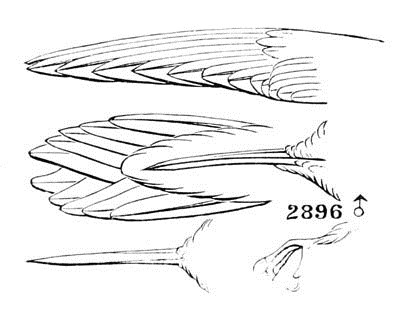
Selasphorus rufus.
2896 ♂
As already stated, the characters of Selasphorus, as distinguished from Calypte (to which it is most nearly related, through the C. floresi), consist in the lack of metallic feathers on the crown, and in the attenuation of the outer primary, and the pointed and acuminate cuneate (instead of forked) tail.
As distinguished from Trochilus, the quills diminish gradually, instead of showing an abrupt transition between the fourth and fifth, so characteristic of the two species of Trochilus, as restricted. The very attenuated tip of the outer primary is a character entirely peculiar to Selasphorus.
The two North American species, though strictly congeneric, differ from each other considerably in details of form, as well as in color. They may be distinguished from each other and from their two Central American allies as follows:—
Species and VarietiesA. Feathers of the metallic gorget not elongated laterally.
S. platycercus. Above continuous metallic green; tail-feathers merely edged with rufous. Gorget purplish-red.
Wing, 1.90; tail, 1.40; bill (from forehead), .66. Gorget rich solferino-purple, the feathers grayish-white beneath the surface. Outer primary with its attenuated tip turned outward. Hab. Rocky Mountains and Middle Province of United States, south to Guatemala … var. platycercus.
Wing, 1.65; tail, 1.20; bill, .41. Gorget dull velvety-crimson, the feathers ochraceous beneath the surface. Outer primary apparently with its attenuated tip curved inward. Hab. Costa Rica … var. flammula.116
B. Feathers of the metallic gorget much elongated laterally.
S. rufus. Above chiefly rufous, overlaid by green (except in S. scintilla, which is almost wholly green above); tail-feathers rufous with a shaft-streak of dusky. Gorget fiery red. Attenuated tip of outer primary curved inwards.
Wing, 1.60; tail, 1.30; bill, .65. Rufous prevailing above; gorget very brilliant. Hab. Western Province of North America, from East Humboldt Mountains to the Pacific. North to Sitka, south to Mirador … var. rufus.


